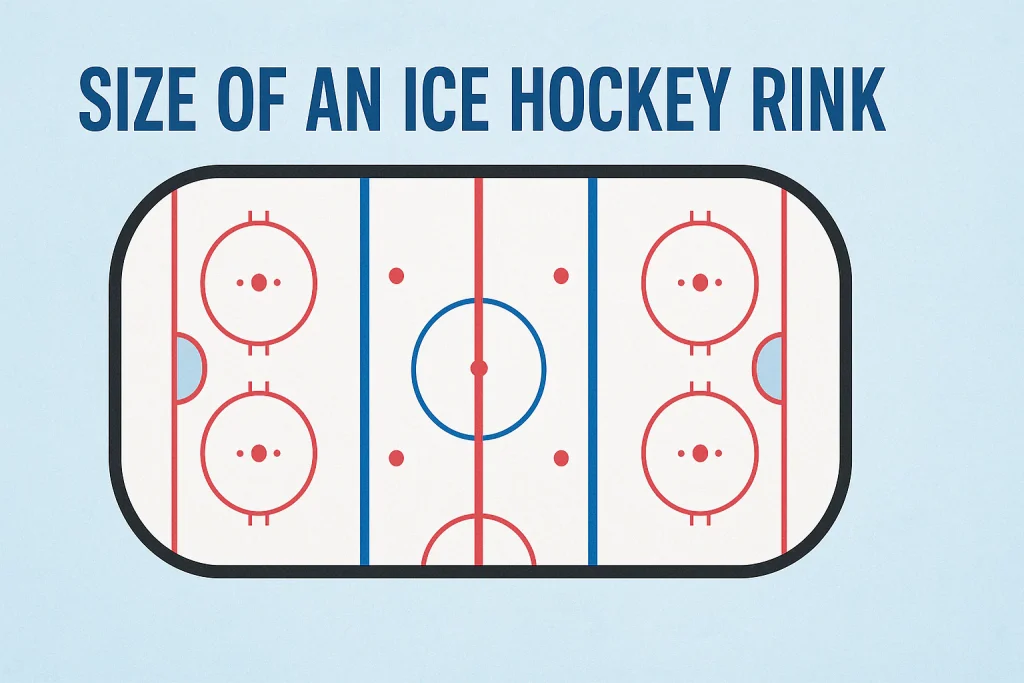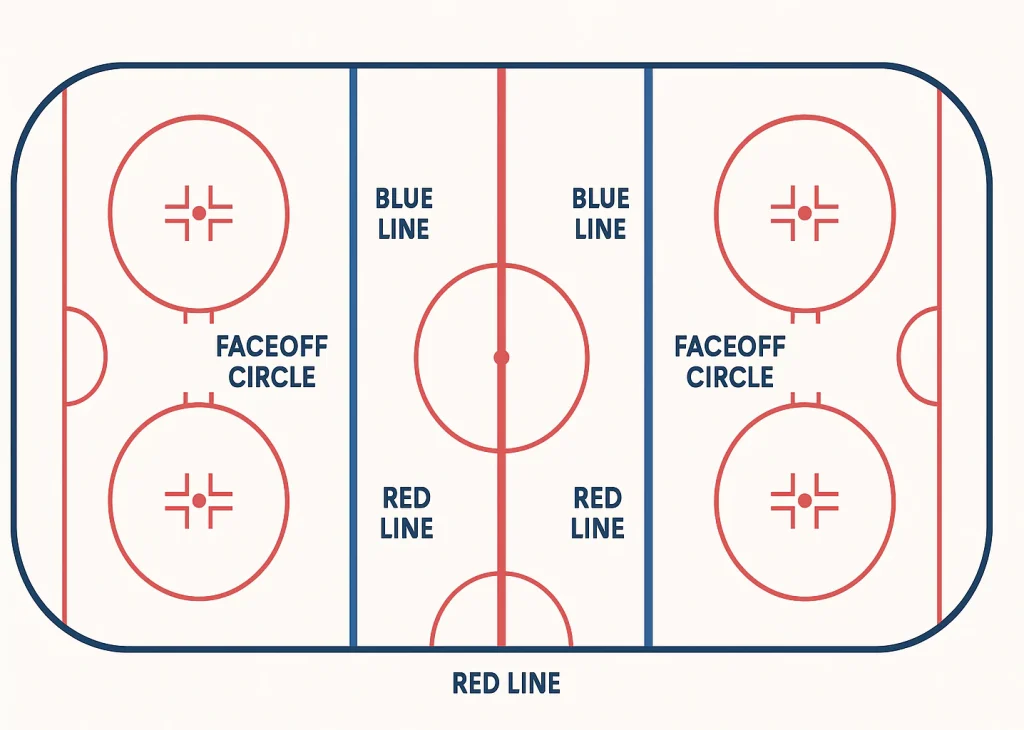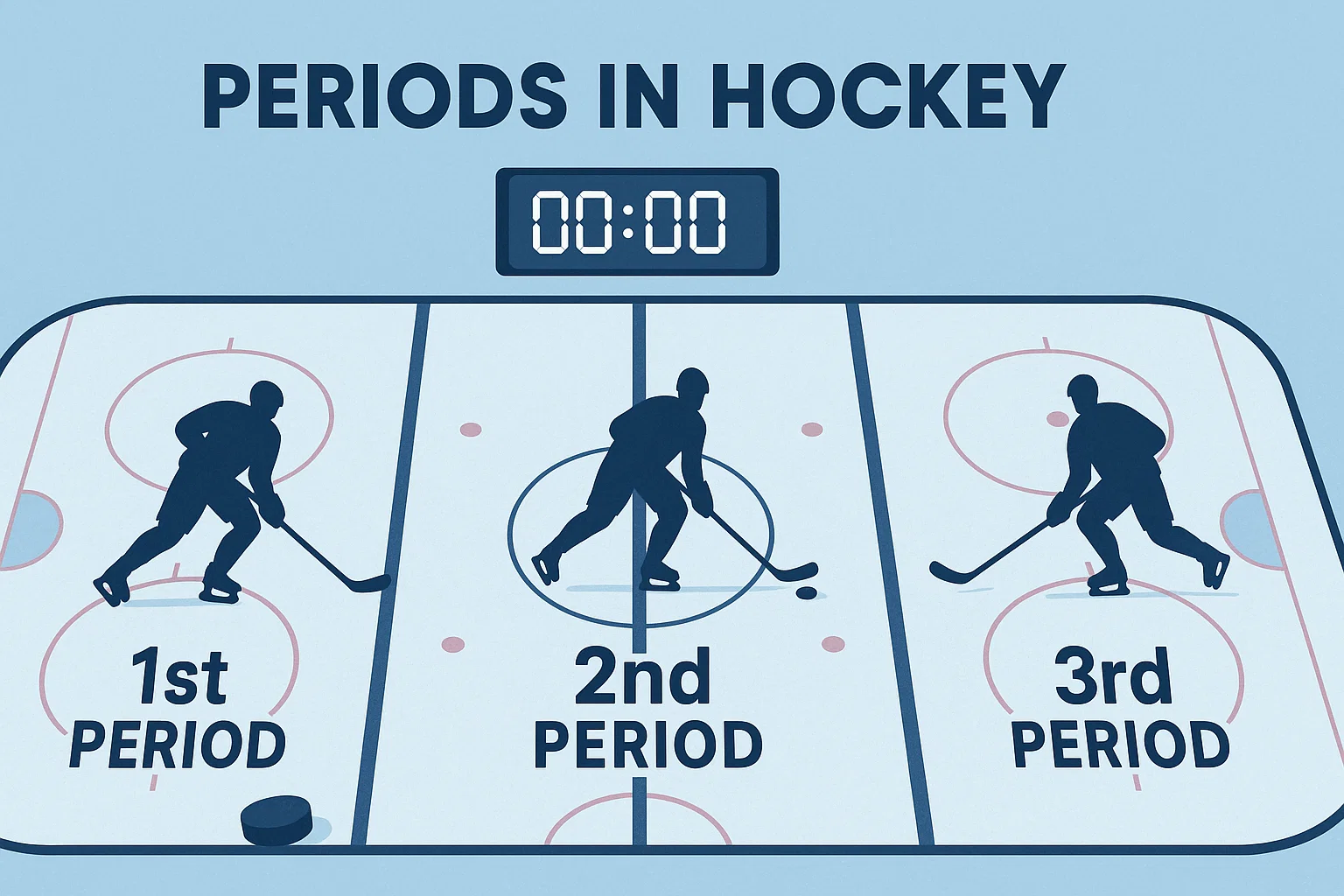If you’re a fan of ice hockey, you’ve likely wondered about the size of an ice hockey rink. Whether you’re watching a game on TV, visiting an arena, or even playing in one, understanding the dimensions of the rink is key to appreciating the sport. The size of the rink influences how the game is played and can vary depending on the level of competition.
In this guide, I’ll walk you through everything you need to know about the standard size of an ice hockey rink, how it compares to other rink types, and why it matters for the game. As someone who has spent years analyzing ice hockey gameplay, I’ve seen firsthand how rink size impacts everything from player strategy to the overall pace of the game. So, let’s dive in and take a closer look at the dimensions of ice hockey rinks around the world and why these measurements matter so much.

Standard Ice Hockey Rink Size
The official size of an ice hockey rink is crucial to the game. The NHL standard rink measures 200 feet long and 85 feet wide. This size is used for professional games in North America, ensuring that all teams play on the same-sized surface during official matches. This size provides enough room for fast-paced action while keeping the game tight and competitive.
The NHL rink size is designed for a balance of space and speed. It’s large enough for players to move, skate, and pass, but not so big that the game becomes too spread out. The dimensions help create exciting, quick shifts and high-intensity moments.
A key factor in maintaining this surface is the Zamboni, a machine that smooths the ice during breaks. If you’ve ever been to an ice hockey game, you’ve probably seen it in action. The Zamboni helps keep the ice quality high, making sure the puck moves well and players can maintain their grip on the surface.
If you’re curious about how the Zamboni works or want more information on rink maintenance, you can visit the Zamboni website.
The dimensions of the rink affect the flow of the game. A smaller rink means the players will have less time to react, which leads to quicker decisions and fast plays. On the other hand, larger rinks, like those in international competitions, allow for a more open style of play.
Olympic and International Ice Hockey Rink Size
An Olympic-sized rink is a bit different from the standard NHL rink. The Olympic rink is 200 feet long but 100 feet wide, which is 15 feet wider than the NHL rink. This extra space allows for a different style of play. Players have more room to move and pass, making the game less intense but more strategic.
In international ice hockey tournaments like the Olympics, this wider rink is used to give athletes more freedom. Teams can stretch out, use the space for better setups, and control the flow of the game. This extra width also makes for longer shifts, as players don’t have to cover the same amount of space as quickly as on an NHL-sized rink.
The size difference between the NHL rink and the Olympic rink leads to different playing styles. On an NHL-sized rink, teams often play a fast, close-quarters game, while on an Olympic rink, players are given more time to think and execute plays. This affects everything from defensive strategies to the pace of the game.
You can learn more about the Olympic rink size and its impact on the rules at the International Ice Hockey Federation (IIHF).
Key Differences:
- Olympic rink size: 200 feet long x 100 feet wide
- NHL rink size: 200 feet long x 85 feet wide
- Impact on gameplay: Larger Olympic rinks allow for more open, strategic plays
Factors Affecting Ice Rink Size
There are several factors that can affect the size of an ice hockey rink. The level of play, country, and even specific event requirements can change the dimensions. Youth rinks, for example, are often smaller to suit the younger players’ abilities and equipment. As players grow and compete at higher levels, the rink size typically increases to accommodate faster, more skilled play.
Another key factor is the regional differences in rink sizes. In countries like Canada and the United States, NHL-standard rinks are most common. However, in other parts of the world, international-size rinks are often used. For instance, in European leagues and international tournaments, you will usually find Olympic-size rinks. These variations can influence the style of the game, as teams may need to adapt to the amount of space available.
Rink size is also affected by the competition level. In professional leagues, like the NHL, there’s a strict regulation of rink size. However, at the amateur and collegiate levels, rink dimensions can vary more, often being smaller to fit the needs of the specific venue. This flexibility makes the game more accessible but can change how the game is played.
For more details on how ice rink sizes vary by region and level, you can visit the NHL’s official site for more information.
Other Key Ice Hockey Rink Measurements

While the length and width of the rink are important, there are other critical measurements to consider. For example, the height of the rink boards is essential for player safety. Standard rink boards are usually about 42 inches tall, providing protection for players from high-speed pucks and collisions with the boards.
Additionally, the surface quality of the ice matters greatly. For the game to be played at its best, the surface must be smooth and even. Ice conditions are closely monitored, and the Zamboni machine helps keep the surface in top condition. Ice resurfacing is done between periods to ensure that the ice doesn’t get rough and slow the game down.
The layout of the rink’s zones also plays a significant role in the flow of the game. The blue lines and red line divide the ice into offensive, defensive, and neutral zones. The faceoff circles are where the game restarts after a stoppage. These markings are essential for the game’s structure and gameplay rules. Understanding where these lines are and what they represent can help you appreciate the strategy behind the game.
For more information about rink markings and their purpose, check out this detailed guide on hockey rink zones.
Why Ice Rink Size Matters for Gameplay
The size of the ice hockey rink is a major factor in how the game is played. On a smaller rink, such as the NHL-sized rink, players have less time and space to react. This leads to faster gameplay, where players rely on quick decisions and tight formations. Smaller rinks encourage physical play and create more opportunities for fast-paced action.
On a larger rink, like an Olympic rink, players have more room to move around. This extra space allows for more strategic plays, with players taking longer shifts and using more open space to create chances. The wider rink changes the dynamics of both offense and defense, with teams needing to adjust their positioning and tactics.
The size also impacts player positioning. On a smaller rink, defensemen have less ground to cover, leading to tighter defense strategies. In contrast, on a larger rink, defensemen may have to cover more ground, allowing for wider setups and better passing lanes. Teams must adapt to the available space to optimize their playstyle.
To understand more about how rink size affects strategy, check out the NHL’s strategy section for more expert insights.
How Ice Rinks Are Built and Maintained
Building an ice hockey rink requires precise planning. Rinks need to meet strict specifications to ensure fair play and safety. The foundation of the rink must be level and strong to support the ice surface. Beneath the rink, a complex cooling system circulates refrigerants to maintain the ice at the right temperature.
Maintenance is another key aspect. Ice rinks need constant care to keep the surface smooth and even. The Zamboni machine is a crucial part of this process, resurfacing the ice between periods to prevent rough spots. Regular maintenance ensures that the game is played on an optimal surface, where players can perform at their best.
One important part of rink maintenance is checking the dimensions. Over time, the rink can shift slightly, so it’s essential to measure and adjust to ensure that the dimensions are within regulation. Keeping the rink at the correct size is crucial for fairness during competitions.
For a deeper look at how rinks are built and maintained, you can read more on the NHL’s rink construction page.
FAQ Section
1. What are the dimensions of an Olympic-sized hockey rink?
An Olympic-sized rink measures 200 feet long by 100 feet wide, which is 15 feet wider than the standard NHL rink. This extra width allows players to spread out and use more strategic plays. If you want to know more about the official rink sizes for international events, you can visit the International Ice Hockey Federation.
2. Are all ice hockey rinks the same size?
No, not all ice hockey rinks are the same size. The NHL rink is typically 200 feet long and 85 feet wide, while Olympic rinks are 200 feet long and 100 feet wide. Additionally, youth rinks are often smaller to suit younger players. These variations influence how the game is played and the strategies used by teams. For more on different rink sizes, check out NHL.com.
3. How does rink size affect the game?
Rink size affects the pace and strategy of the game. Smaller rinks, like the NHL rink, make the game faster and more physical, with less time for players to react. Larger rinks, like those used in the Olympics, give players more space, leading to more strategic play and longer shifts. If you’re interested in learning how rink size influences tactics, take a look at the IIHF’s rulebook.
4. Can an ice rink be resized for different events?
Yes, an ice rink can be resized for specific events. For example, NHL rinks and Olympic rinks have different dimensions, but organizers can adjust rink sizes depending on the event. This allows the game to be played on the most suitable surface for the event. For more information on rink modifications, visit the IIHF’s event guidelines.
Conclusion
To summarize, the size of an ice hockey rink is essential for shaping the game. The standard NHL rink is 200 feet long and 85 feet wide, while Olympic-sized rinks measure 200 feet by 100 feet. The rink size influences gameplay speed, player strategy, and team tactics. Whether it’s the smaller, faster NHL rink or the wider Olympic rink, the size of the rink plays a crucial role in how the game unfolds.
If you’re planning to watch a game, understanding the rink’s dimensions can enhance your experience. From youth leagues to international competitions, rink sizes vary, but they all serve to make ice hockey the exciting, dynamic sport we love.
Ready to dive deeper into the rules and regulations surrounding ice hockey? Be sure to check out official resources like NHL.com and IIHF for more information on rink sizes and other related topics.
 Sports Daily Info All Things Sports, from News to Match Schedules
Sports Daily Info All Things Sports, from News to Match Schedules



